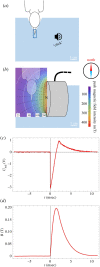No apparent effect of a magnetic pulse on free-flight behaviour in northern wheatears (Oenanthe oenanthe) at a stopover site
- PMID: 35167773
- PMCID: PMC8847002
- DOI: 10.1098/rsif.2021.0805
No apparent effect of a magnetic pulse on free-flight behaviour in northern wheatears (Oenanthe oenanthe) at a stopover site
Abstract
Naïve migrants reach their wintering grounds following a clock-and-compass strategy. During these inaugural migrations, birds internalise, among others, cues from the Earth's magnetic field to create a geomagnetic map, with which they navigate to destinations familiar to them on subsequent migrations. Geomagnetic map cues are thought to be sensed by a magnetic-particle-based receptor, which can be specifically affected by a magnetic pulse. Indeed, the orientation of experienced but not naïve birds was compromised after magnetic pulsing, indicating geomagnetic map use. Little is known about the importance of this putative magnetoreceptor for navigation and decision-making in free-flying migrants. Therefore, we studied in unprecedented detail how a magnetic pulse would affect departure probability, nocturnal departure timing, departure direction and consistency in flight direction over 50-100 km in experienced and naïve long-distant migrant songbirds using a large-scale radio-tracking system. Contrary to our expectations and despite a high sample size (ntotal = 137) for a free-flight study, we found no significant after-effect of the magnetic pulse on the migratory traits, suggesting the geomagnetic map is not essential for the intermediate autumn migration phase. These findings warrant re-thinking about perception and use of geomagnetic maps for migratory decisions within a sensory and ecological context.
Keywords: bird migration; geomagnetic map; magnetic pulse; magnetic-particle-based sensor; magnetoreception; navigation.
Figures



Similar articles
-
A magnetic pulse does not affect free-flight navigation behaviour of a medium-distance songbird migrant in spring.J Exp Biol. 2022 Oct 1;225(19):jeb244473. doi: 10.1242/jeb.244473. Epub 2022 Oct 3. J Exp Biol. 2022. PMID: 36111526 Free PMC article.
-
A conceptual framework on the role of magnetic cues in songbird migration ecology.Biol Rev Camb Philos Soc. 2024 Aug;99(4):1576-1593. doi: 10.1111/brv.13082. Epub 2024 Apr 17. Biol Rev Camb Philos Soc. 2024. PMID: 38629349 Review.
-
Nocturnal departure timing in songbirds facing distinct migratory challenges.J Anim Ecol. 2018 Jul;87(4):1102-1115. doi: 10.1111/1365-2656.12821. Epub 2018 Mar 30. J Anim Ecol. 2018. PMID: 29504627
-
Stopover optimization in a long-distance migrant: the role of fuel load and nocturnal take-off time in Alaskan northern wheatears (Oenanthe oenanthe).Front Zool. 2013 May 12;10(1):26. doi: 10.1186/1742-9994-10-26. Front Zool. 2013. PMID: 23663358 Free PMC article.
-
Feasibility of sun and magnetic compass mechanisms in avian long-distance migration.Mov Ecol. 2018 Jun 6;6:8. doi: 10.1186/s40462-018-0126-4. eCollection 2018. Mov Ecol. 2018. PMID: 29992024 Free PMC article. Review.
Cited by
-
Biological Effects of Electric, Magnetic, and Electromagnetic Fields from 0 to 100 MHz on Fauna and Flora: Workshop Report.Health Phys. 2023 Jan 1;124(1):39-52. doi: 10.1097/HP.0000000000001624. Epub 2022 Nov 3. Health Phys. 2023. PMID: 36480584 Free PMC article.
-
The oxidative balance and stopover departure decisions in a medium- and a long-distance migrant.Mov Ecol. 2023 Feb 6;11(1):7. doi: 10.1186/s40462-023-00372-7. Mov Ecol. 2023. PMID: 36747277 Free PMC article.
-
Prussian blue technique is prone to yield false negative results in magnetoreception research.Sci Rep. 2022 May 25;12(1):8803. doi: 10.1038/s41598-022-12398-9. Sci Rep. 2022. PMID: 35614116 Free PMC article.
-
A magnetic pulse does not affect free-flight navigation behaviour of a medium-distance songbird migrant in spring.J Exp Biol. 2022 Oct 1;225(19):jeb244473. doi: 10.1242/jeb.244473. Epub 2022 Oct 3. J Exp Biol. 2022. PMID: 36111526 Free PMC article.
-
A refined magnetic pulse treatment method for magnetic navigation experiments with adequate sham control: a case study on free-flying songbirds.J R Soc Interface. 2024 May;21(214):20230745. doi: 10.1098/rsif.2023.0745. Epub 2024 May 15. J R Soc Interface. 2024. PMID: 38745460 Free PMC article.
References
-
- Salewski V, Bairlein F, Leisler B. 2000. Recurrence of some palaearctic migrant passerine species in West Africa. Ringing Migr. 20, 29-30. (10.1080/03078698.2000.9674224) - DOI
-
- Holland RA. 2014. True navigation in birds: from quantum physics to global migration. J. Zool. 293, 1-15. (10.1111/jzo.12107) - DOI
Publication types
MeSH terms
Supplementary concepts
Associated data
LinkOut - more resources
Full Text Sources

